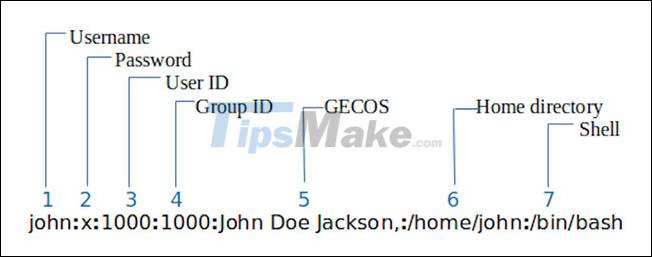What is the file /etc/passwd? What is the /etc/passwd file used for?
This tutorial will help you understand what a passwd file is and its important role when managing users in Linux.
What is the file /etc/passwd?
The passwd file in Linux is a configuration file that contains detailed information about the user. An important feature of the passwd file is that it is an ASCII text file that the user can edit easily with any text editor such as Nano and Vim.
Although you can add and manage users directly using the passwd file, it is not recommended because this action is prone to typos and causes problems. Instead, you should use various user management commands like useradd to add users to your system.
View the file /etc/passwd
To view the contents of the passwd file, you can use any text editor or file viewer command tool. In this tutorial, the article will use the cat command:
cat /etc/passwdThe output will be similar to below.

Each line actually represents one user on your system, so don't be surprised if you have a lot of users listed. Most of them are system users that control specific applications on your Linux machine. For example, the mail user is responsible for the Mail application .
Explanation of fields in /etc/passwd . file
From the output above, it is very clear that the file /etc/passwd follows a very specific pattern.
Each user line is further subdivided into 7 sections or fields separated by a colon (:) character as shown below.

1. Username
The first field in a line represents the user's username or login name. In the example above, the username is john.
2. Password
The second field shows the user's encrypted password. For security purposes, passwords are kept in a separate file that cannot be read by ordinary users. The file /etc/shadow stores the user's password in Linux.
Usually, the password field contains an x to indicate that the shadow file is securely storing the password. If the field is empty, the user does not need a password to login. To maintain overall system security, every user on your system must have a password. You can use the passwd command to change or manage user passwords in Linux.
3. User ID
The User ID field, commonly referred to as the UID, is a number used by the Linux system to identify the user. Most system users have User ID less than 1000 while general users have ID 1000 or more. The root user (admin) usually has an ID of 0.
4. Group ID
The fourth field is for the group ID (commonly known as the GID). Like user ID, GID is also a number. The group ID identifies a user's primary group. In addition, GID categorizes all users in specific groups for easier administration. A user can belong to multiple groups in Linux. To learn more about the user group you belong to, you can see the file /etc/group.
cat /etc/group5. GECOS
The next school is the GECOS school. It usually contains the user's full name and additional details such as phone or room numbers, separated by commas. This field is optional and can therefore be left blank.
6. Home Directory
This field contains the /home directory associated with the user. This is the home directory that stores the main user files and directories like /Desktop and /Pictures. In this example, the user's home directory is /home/john.
Having separate home directories for each user is one of the factors that allows Linux to become a truly multi-user operating system.
7. Shell
This field contains the name of the default shell associated with the user. Shell is the environment in which users can run commands and scripts. Most Linux distributions use Bourne Again Shell (Bash) as the default shell program.
 How to Fix Bluetooth Connection Problems in Ubuntu
How to Fix Bluetooth Connection Problems in Ubuntu The Cat command in Linux
The Cat command in Linux The 5 best Linux server distributions
The 5 best Linux server distributions Fix USB not working in Linux
Fix USB not working in Linux How to install and use Caliber on Linux
How to install and use Caliber on Linux The latest features of GNOME 40
The latest features of GNOME 40